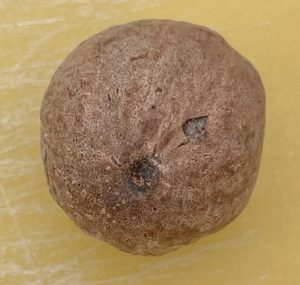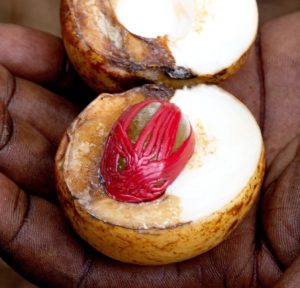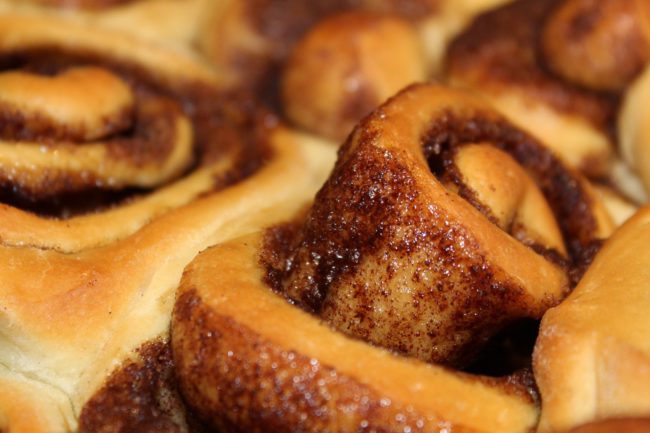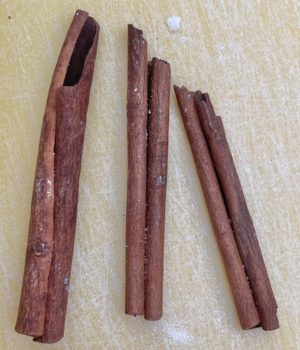Seasonal spices

At this time of year, certain flavourings come to the fore. Cloves, nutmeg and cinnamon are a bit more prominent than at other times of year. Though widely used in many cultures and cuisines, they are perhaps more associated with the winter months and Christmas. Nutmeg comes from a dark leaved, evergreen tree Myristica fragrans. The tree is indigenous to the Maluku Islands of Indonesia (specifically the Banda Islands), but is now widely grown in Indonesia, Malaysia, Grenada in the Caribbean and Kerala in India. The tree is dioecious, that is to say, there are male and female trees. Male trees are unproductive in terms of nutmeg harvest, so grafting of cuttings from female trees is often used to produce new plants. The trees take some twenty years to reach ‘peak production’.
 The fruit of the tree yields the Nutmeg, and the covering of the seed (the aril) is the source of Mace. The fruits are gathered up and dried in the sun (for some 6 to 8 weeks). As the structure dries, the husk (seed coat) and seed separate. The seed coat or shell is then broken and the seed picked out; it is separated from the reddish aril, which is the source of mace. The grinding of the seed yields nutmeg. Nutmeg has a distinctive, somewhat pungent fragrance and contributes a warm, slightly sweet taste to food. It is used to flavour mulled wine, punches and cider, added to pumpkin pie and can be used to ‘spice up’ baking, from gingerbread to muffins or chocolate and fruit cakes. Nutmeg oil, which can be produced by a process of steam distillation, is rich in terpenes (like pinene and limonene). It, too, can be used as a food flavouring or in products like toothpaste ! Mace, from the covering of the seed, has a more delicate flavour (than nutmeg) and may give a saffron-like colour to dishes - which may range from meat recipes to Christmas pudding.
The fruit of the tree yields the Nutmeg, and the covering of the seed (the aril) is the source of Mace. The fruits are gathered up and dried in the sun (for some 6 to 8 weeks). As the structure dries, the husk (seed coat) and seed separate. The seed coat or shell is then broken and the seed picked out; it is separated from the reddish aril, which is the source of mace. The grinding of the seed yields nutmeg. Nutmeg has a distinctive, somewhat pungent fragrance and contributes a warm, slightly sweet taste to food. It is used to flavour mulled wine, punches and cider, added to pumpkin pie and can be used to ‘spice up’ baking, from gingerbread to muffins or chocolate and fruit cakes. Nutmeg oil, which can be produced by a process of steam distillation, is rich in terpenes (like pinene and limonene). It, too, can be used as a food flavouring or in products like toothpaste ! Mace, from the covering of the seed, has a more delicate flavour (than nutmeg) and may give a saffron-like colour to dishes - which may range from meat recipes to Christmas pudding.
Cinnamon is used extensively in many cuisines and even in scented candles. It is one of the most commonly used spices in Sweden. Indeed, such is the ‘importance’ of their cinnamon buns - kanelbullar - that the Swedes now have an official Cinnamon Bun Day - on October 4th!

Cinnamon 'buns'
Together with other spices such as turmeric, saffron, sumac, and cardamom, cinnamon is widely used in Portuguese, Turkish and Persian Cooking.
The properties of cinnamon come from the chemicals - cinnamaldehyde and eugenol. The cinnamaldehyde is largely responsible for the flavour and aroma of cinnamon, whilst the eugenol has a pleasant, spicy, clove-like scent. Cinnamon comes from the inner bark of trees of the genus Cinnamomum, the trees belong the Laurel family.
They are four main species associated with cinnamon production “
- Cinnamomum verum
- Cinnamomum burmannii
- Cinnamomum cassia
- Cinnamomum loureiroi
C. verum has its origins in Sri Lanka and is sometimes referred to as ‘true cinnamon’, with the material derived from other sources sometimes referred to as “cassia’. The material derived from the different Cinnamomum species has different physical properties. Ceylon cinnamon gives a thin inner bark of a light brown colour, with a crumbly texture. It has a subtle and aromatic flavour. , whereas, Cassia has a stronger, spicy flavour (and is much used in baking). Most of the world’s production of cinnamon cassia now comes from Indonesia and China. Cinnamon and cassia are often used interchangeably.

The trees are evergreen, with oval shaped leaves and a thick bark. When a tree is two years old, it is coppiced. That is, it is cut back to ground level so that in the following year a number of shoots are produced, which are allowed to grow on for future harvesting. When cut, the stems have the outer bark is scraped off so that the inner bark can be removed. It is this material that is rich in the spice. As it dries, it curls up into rolls or ‘quills’.
Like many spices and metals, cinnamon was extensively traded across the ancient world. It was utilized as a perfume in rubbing oils and was also used as a fragrance in the mummification / preservation of dead bodies in ancient Egypt. Nero was said to have burned enormous quantities of the spice / incense at the funeral of his wife (Poppaea). In recent times, cinnamon rich materials have been investigated for medical uses, specially in relation to type 2 diabetes and blood sugar control.
Thanks to Pixabay for images (Emmie_Norfolk and aga2rk)
Comments are closed for this post.
